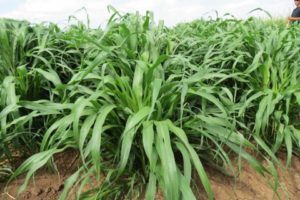by Calvin Trostle, Extension Agronomy, Lubbock, (806) 723-8432, ctrostle@ag.tamu.edu
In the May 4, 2015 edition of Texas Row Crops Newsletter I outlined how hybrid pearl millet (HPM) might be an alternative to sorghum/sudan (haygrazer) for forage production in Texas. The general consensus is that HPM is a “poor host” of sugarcane aphids. Since then more documentation has occurred to demonstrate that HPM is indeed forage that SCA does not prefer, and we continue to view HPM as a poor host.
Counts of SCA on adjacent rows of HPM and infested grain sorghum in the High Plains in 2016 showed that although a few SCA were found in HPM, there was little colonization (most conservatively defined as one adult and one nymph together on the leaf). One September example at Lubbock, typical of most results, reported 78 SCA per leaf on the lowest fully green leaf in grain sorghum, and 215 SCA on the topmost fully expanded green leaf. In contrast the adjacent row of HPM has 1.4 and 3.0 SCA per comparable leaf, with no colonies.
In one case we did find widely scattered colonies of SCA in a hybrid pearl millet with SCA colonies up to 60 aphids and slight production of honeydew. One High Plains IPM Extension agent notes that in 2015 there was one field in Hale Co. that was sprayed for SCA due to damage to the foliage. This is rare.
The bottom line is that producers concerned about SCA in sorghum forages may consider hybrid pearl millet, but since we have seen some infestation and on one unknown field hybrid, it is good to scout the millet to ensure any SCA presence remains low.
What about SCA control in sorghum/sudan?
There have been no thresholds developed for sorghum forages, and no company currently notes any hybrid they feel has tolerance let alone resistance. For SCA infestations in sorghum/sudan or haygrazer, where baling or grazing is the objective, if SCA becomes bad the application of sprays for SCA control with Sivanto or Transform will not likely penetrate the canopy, and only partial control may be achieved. An alternative strategy is to pour the grazing cattle in OR harvest for hay as soon as possible then look to control SCA in the regrowth up to 12” tall when you can get good canopy penetration with a high-pressure/high-volume spray.
For additional information about hybrid pearl millet management consult:
Central and East Texas: “Warm-season annual forage grasses for Texas” (2012), E-630, Texas A&M AgriLife Extension Service (V.A. Corriher), http://foragefax.tamu.edu/files/2013/05/WSAForagesforTexas.pdf
West Texas: “Millets for Forage and Grain in New Mexico and West Texas” (2012), A-417, New Mexico Cooperative Extension Service (M.A. Marsalis, L.M. Lauriault, C. Trostle), http://lubbock.tamu.edu/files/2012/07/Millets-for-NM-West-TX-2012-A-417.pdf
Earlier 2015 Hybrid Pearl Millet/SCA Document: To review the previous document (soon to be updated) visit http://lubbock.tamu.edu and search for ‘millet’ on the main page.

